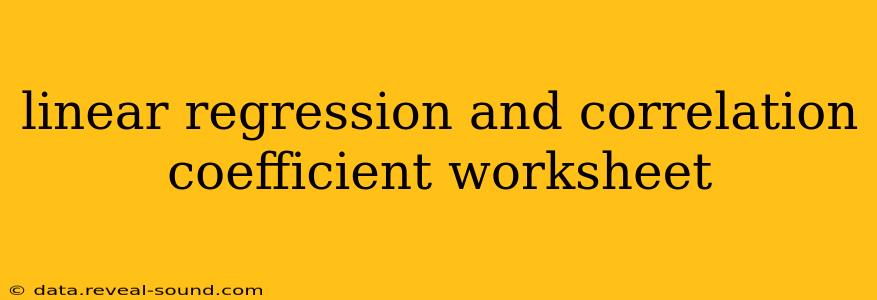This worksheet provides a comprehensive guide to understanding and applying linear regression and correlation coefficients. We'll explore the concepts, calculations, and interpretations, equipping you with the skills to analyze data effectively. Understanding these statistical tools is crucial in many fields, from finance and economics to biology and engineering.
What is Linear Regression?
Linear regression is a statistical method used to model the relationship between a dependent variable (often denoted as 'y') and one or more independent variables (often denoted as 'x'). The goal is to find the best-fitting straight line through a set of data points. This line, represented by an equation of the form y = mx + c (where 'm' is the slope and 'c' is the y-intercept), allows us to predict the value of 'y' given a value of 'x'. The "best-fitting" line is determined by minimizing the sum of the squared differences between the observed values of 'y' and the values predicted by the line. This method is known as the least squares method.
Types of Linear Regression
- Simple Linear Regression: Involves one independent variable and one dependent variable.
- Multiple Linear Regression: Involves two or more independent variables and one dependent variable.
What is a Correlation Coefficient?
The correlation coefficient (often denoted as 'r') measures the strength and direction of the linear relationship between two variables. It ranges from -1 to +1:
- r = +1: Perfect positive correlation (as one variable increases, the other increases proportionally).
- r = 0: No linear correlation (no relationship between the variables).
- r = -1: Perfect negative correlation (as one variable increases, the other decreases proportionally).
The closer the absolute value of 'r' is to 1, the stronger the linear relationship. A value of 0.7 or higher (or -0.7 or lower) generally suggests a strong correlation. However, correlation does not imply causation. Just because two variables are correlated doesn't mean one causes the other. There could be a third, confounding variable at play.
Calculating the Correlation Coefficient
The formula for the Pearson correlation coefficient (the most common type) is:
r = Σ[(xi - x̄)(yi - ȳ)] / √[Σ(xi - x̄)²Σ(yi - ȳ)²]
Where:
- xi and yi are individual data points.
- x̄ and ȳ are the means of the x and y variables, respectively.
- Σ represents the sum of the values.
While this formula looks daunting, statistical software and calculators can easily compute it.
Understanding the Relationship Between Linear Regression and Correlation
The correlation coefficient is closely related to linear regression. The correlation coefficient helps determine the strength and direction of the linear relationship, informing whether linear regression is an appropriate modeling technique. A strong correlation (r close to +1 or -1) suggests a good fit for a linear regression model. A weak correlation (r close to 0) indicates that a linear model may not be appropriate, and other methods should be considered. The square of the correlation coefficient (r²) represents the coefficient of determination, which signifies the proportion of variance in the dependent variable explained by the independent variable(s) in the regression model.
Frequently Asked Questions
What are the assumptions of linear regression?
Linear regression relies on several key assumptions:
- Linearity: The relationship between the dependent and independent variable(s) is linear.
- Independence: The observations are independent of each other.
- Homoscedasticity: The variance of the errors is constant across all levels of the independent variable(s).
- Normality: The errors are normally distributed.
Violations of these assumptions can lead to inaccurate or misleading results. Diagnostic plots are frequently used to check for assumption violations.
How do I interpret the slope and intercept in a linear regression equation?
The slope (m) represents the change in the dependent variable (y) for a one-unit change in the independent variable (x). The y-intercept (c) represents the value of y when x is 0.
What is the difference between correlation and regression?
Correlation measures the strength and direction of a linear relationship between two variables, while regression models the relationship and allows for prediction of one variable based on the other. Regression goes beyond simply identifying a relationship; it quantifies it and allows for predictions.
Can I use linear regression with non-linear data?
No, linear regression is only appropriate for data exhibiting a linear relationship. If the relationship is non-linear, transformations of the variables or other non-linear regression techniques should be considered.
This worksheet provides a foundational understanding of linear regression and the correlation coefficient. Further exploration of statistical concepts and software applications will enhance your ability to use these powerful tools in data analysis. Remember to always carefully consider the assumptions of linear regression and interpret the results in the context of the data and research question.
